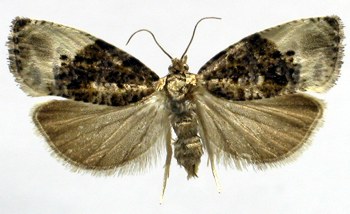Pests
Hedya nubiferana Haworth - Green Budworm Moth, Green Budmoth, Marbled Orchard Tortrix
Systematic position.
Class Insecta, order Lepidoptera, family Tortricidae, subfamily Olethreutinae, tribe Olethreutini, genus Hedya.Synonyms.
Olethreuthes variegana Hbn., Agyroploce variegana Hbn., Hedya dimidioalba Retzius.Biological group.
This is a polyphagous pest of rosaceous fruit trees and bushes.Morphology and biology.
Fore wings in basal part are brown or dark gray with bluish tint, with white specks at inner margin (wingspan 17-21 mm). Distal part is white with bluish-gray, brown, or black strokes. An isolated black spot is located near border of dark and light parts of the wing. Fringe is gray-brown. Hind wings are gray-brown. Fresh eggs look like a transparent drop, later becoming milky-white. Caterpillars of younger instars are white-yellow, older caterpillars are darker (olive-green or dark gray-green), with almost black warts. Pupa 9-14 mm, dark-brown to black; cremaster in the form of truncated cone, with 8 hooked setae at apex. Average fertility of females is 127 (without additional feeding) to 352 (140 to 580) eggs (moths feeding on a sugar syrup). Eggs are laid one by one or in small groups on leaves mainly, rarely on fruits. The period of embryonic development lasts 8-13 days. Summer caterpillars feed for about one month; they usually cause insignificant harm. The caterpillars finish their activity in July, passing from development into a long diapause lasting about 10 months. Caterpillars of 3rd instar winter in silky cocoons under dry bud scales, under dried leaves attached by web thread to branchlets, and in bark cracks. The wintered caterpillars mainly penetrate fruit buds, eating away their contents; the buds grow brown, dry up and fall. Later the caterpillars roll leaves, compiling friable bunches; damaging buds, flowers, and ovaries. Fruits are seldom damaged. Pupation occurs in feeding places or between two leaves strapped by web thread. The pupal stage lasts 20 days on the average at temperature 15°C.Distribution.
The species inhabits Western Europe, Asia Minor, Iraq and Iran and was brought to the USA and Canada. In the former USSR it is distributed in the European part (from the White Sea coast to the Caucasus), in Transcaucasia, Ural, Kazakhstan, mountains of Turkmenistan, in Western Siberia.Ecology.
This species is monovoltine. In spring the caterpillars renew feeding at the average daily temperature of 9-10°C during apple bud blossoming (green tops status). Pupation occurs at the end of June or in the beginning of July. In Crimea the pupae develop over 20 days on the average at temperature 15°C and relative air humidity 60%, and over 11 days at 18°C and 50% humidity. Moth flight begins two weeks after flowering of apple trees, lasting 3-4 weeks. Oviposition begins 2-3 days after emergence of the imagoes. Females (with additional feeding on sugar syrup) live 36 days, and males 30 days on the average. Caterpillars hatch in 1st third of June (Crimea).Economic significance.
This is a pest of gardens in the south of the European part of the former USSR and in the Caucasus. Caterpillars cause harm, eating away buds and flower buds, to apple, pear, plum, quince, cherry, sweet cherry, apricot, mountain ash, hawthorn, raspberry, cotoneaster, roses and other rosaceous.Control measures.
Agronomical measures include pruning old and diseased branches. Biological measures include application of biological preparations. Chemical measures include local insecticide treatments during development of over-wintered caterpillars before flowering of trees (during the phase of red buds) in spring. Monitoring and forecast are possible with the use of pheromone traps.Reference citations:
Galetenko S.M. 1964. To morphology of fruit leafrollers. In: Kochkin M.A., Rubtsov N.I., Ryndin N.V., eds. 150 years to State Nikitskii botanical garden. Collection of scientific works. V. 37. Moscow: Kolos. 531-395 p. (In Russian)Kostyuk Yu.A. 1974. Family Tortricidae. In: Vasil.ev V.P., ed. Pests of agricultural crops and forest plantations. V. 2. Arthropods. Kiev: Urozhai. 261-320 p. (In Russian)
Kuznetsov V.I. 1994. Family Tortricidae. In: Kuznetsov V.I., ed. Insects and mites - pests of agricultural plants. V. 3(1). Lepidoptera. St. Petersburg: Nauka. 51-234 p. (In Russian)
Litvinova A.N. 1969. On preferences to host plants in caterpillars of dendrophilous leafrollers (Lepidoptera, Tortricidae). Vestsi Akademii navuk BSSSR. Seryya byalagichnykh navuk (Minsk: Navuka i tekhnika) 4: 107-109. (In Russian)
Savkovskii P.P. 1976. Atlas of the pests of fruit and berry plants. Kiev: Urozhai. 207 p. (In Russian)
Vasil.ev V.P., Livshits I.Z. 1984. Pests of fruit crops. Moscow: Kolos. 399 p. (In Russian)


